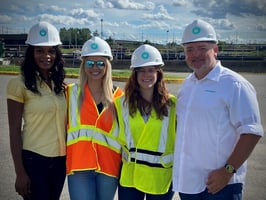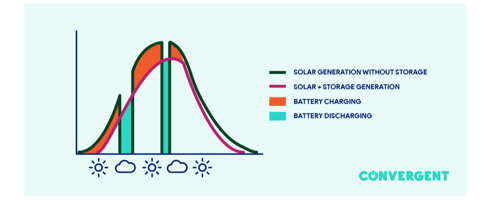Engineering Sustainable Energy Solutions: Q&A with Simi Falase, VP, Engineering at Convergent

Engineering is critical to the success of all renewable energy initiatives—such as energy storage (typically in the form of a battery) and solar photovoltaics (PV). Many of our customers are interested in pursuing renewable energy systems but do not always have the technical expertise or resources to design and implement a utility-scale or industrial-scale system. That’s why it’s so important to have a trusted partner every step of the way (spoiler alert: that partner is Convergent Energy and Power!). Our engineering team is responsible for a range of necessary processes—from system design and technical feasibility studies to navigating all interconnection and permitting applications.
We sat down with our Vice President of Engineering, Simi Falase, to discuss the role of engineering in bringing a renewable energy system online, including the many challenges and opportunities engineering teams face along the way.
[The following Q&A has been edited for clarity and brevity]
Q: What are the key considerations when designing an energy storage and/or solar PV system?
A: Engineering design hinges on several important considerations in the comprehensive process of defining a system. One key factor is land assessment, which involves evaluating the available buildable area and the parcel's proximity to the point of interconnection (POI). These aspects significantly influence the system's layout and feasibility, guiding infrastructure placement and resource utilization decisions.
After land assessment, the next step is permitting. Permitting entails understanding and adhering to local Authority Having Jurisdiction (AHJ) requirements concerning civil/structural, electrical system, and safety system design.
The interconnection process poses its own set of processes. Engineers must analyze the interconnection voltage, assess available electrical generation and load capacity at the proposed POI, and comprehend utility/customer technical requirements (Simi covers the interconnection process in greater detail later in this blog).
Lastly, revenue stream considerations are essential for the system's financial viability. This includes determining the technical requirements for revenue program participation, such as system configuration (e.g., AC versus DC coupling), metering (e.g., net metering, aux load metering), and specific use cases (e.g., blackstart, islanding).
Collectively, these considerations guide the development of a precise engineering design that meets regulatory standards, optimizes performance, and achieves the desired solution outcomes.
Q: Can you explain how energy storage works and the basic components that make up an energy storage system?
A: Energy storage systems allow electricity to be stored—and then discharged—at the most strategic times. Today, Lithium-ion batteries, the same batteries that are used in cell phones and electric vehicles, are the most commonly used type of energy storage. Like the batteries in your cell phone, commercial-, industrial-, and utility-scale battery energy storage systems can be charged with electricity from the grid, stored, and discharged when there is a deficit in supply or when energy is most expensive. Increasingly, battery energy storage is being paired with solar PV, which maximizes the value of solar energy to the grid (i.e., storing solar-generated electricity for when it is cloudy or after the sun sets).

The basic components of an energy storage system include:
- The Battery DC Blocks are comprised of the battery cells, which are the basic unit of the storage system where the energy is stored. Cells are connected in series into modules, then stacks, and, finally, packaged as energy storage “containerized” or “modular” blocks.
- Inverters are the component of the solar-plus-storage system that converts the energy from DC (how the energy would be generated in the solar modules and stored in the battery) to AC (how it is transmitted and utilized by the grid).
- Transformers are needed to step up the AC voltage at the inverter of the battery energy storage system to the utility voltage.
- The Energy Management System (EMS) is software that manages/optimizes the overall system operation. At Convergent, we use PEAK IQ®, our AI-powered energy storage intelligence that makes data-driven decisions about when and how to charge and discharge our battery storage systems for optimal value creation.
- Balance of Plant refers to all the other supporting electrical components of the battery energy storage or solar PV system, including protection devices (breakers, relays, etc.), power conductors, auxiliary power supply, communications, and metering.
- If pairing the system with solar, PV Arrays are used to capture energy for an energy storage system that includes solar PV (solar-plus-storage). A module is a collection of PV cells; these modules are connected together in series to make up panels held up by a racking system.
Understanding these components is essential for anyone looking to implement or optimize an energy storage system (with or without solar PV) within their renewable energy strategy.
Q: How do we interconnect our battery storage and/or solar PV systems to the grid?
A: All our systems are subject to interconnection, which is the process of requesting and gaining authorization from the local electric utility to connect the system to the utility's electric grid. The exact process and requirements for interconnection may be different depending on a variety of factors, such as local utility requirements, independent system operator (ISO)/regional transmission organization (RTO), if the system is interconnecting at the transmission level or distribution level, and if the system is in front of the meter (FTM) or behind the meter (BTM), among other factors. However, most systems will follow this typical interconnection path:
1. Pre-Application – Pre-application reports from the utility help evaluate the ability of the existing grid and identify known constraints.
2. Interconnection Request – The application deposit/fee, technical documents, other system-related technical details, and use-cases are submitted as inputs to the utility electrical study.
3. Feasibility Study – A preliminary review performed by the utility that identifies the impact of the distribution system.
4. System Impact Study – A study performed by the utility/ ISO/RTO, typically on larger systems, to identify project-specific system reliability needs.
5. Facility Study – A detailed engineering study that estimates costs associated with system upgrades.
6. Interconnection Agreement – Final contract between utility and system entity that states the conditions for interconnection.
Adhering to this structured interconnection path ensures the smooth and efficient integration of our systems with the utility's electric grid.

Q: What advancements in energy storage technology are you most excited about?
A: There is so much exciting stuff happening in the energy storage industry, but here are a few that our team expects to be transformative. Firstly, advances in energy storage safety are noteworthy. Safety is a core value for our team, so we are pleased to see improved safety design standards in energy storage systems. Secondly, the maturity of non-lithium-ion battery energy storage systems technologies is promising. Lithium-ion technologies are not designed for long-duration storage (defined as 8 hours or more). I’m excited to see what technologies develop, as well as advancements in long-duration storage.
Q: What’s your favorite part of your job?
A: That’s easy! My favorite part of my job is collaborating with the best team of subject matter experts to realize systems that provide value to our customers! Our project origination, development, execution, and operations teams are always willing (and certainly able) to take on the most challenging and complex systems to support the clean energy transition.

Simi (on the far left) with members of the Engineering/PX team during their escape room outing.
\\\
Conclusion: Moving Forward on Your Energy Storage and Solar System
If you’re ready to move forward on your energy storage and/or solar PV system but unsure if you have the right technical expertise and/or resources, Convergent’s engineering team can help. We can also help even if you have a clear vision of your technical needs by managing the interconnection process and system operations and maintenance. We are proud of our commitment to sustainable practices and our 12-year track record of renewable energy expertise.
As a leading developer, owner, and operator of renewable energy solutions in North America, we excel in engineering and implementing utility-scale energy storage and solar-plus-storage systems.
If you’re interested in learning more about how energy storage (with or without solar generation) can benefit your organization, please contact us today for a free, customized evaluation.


